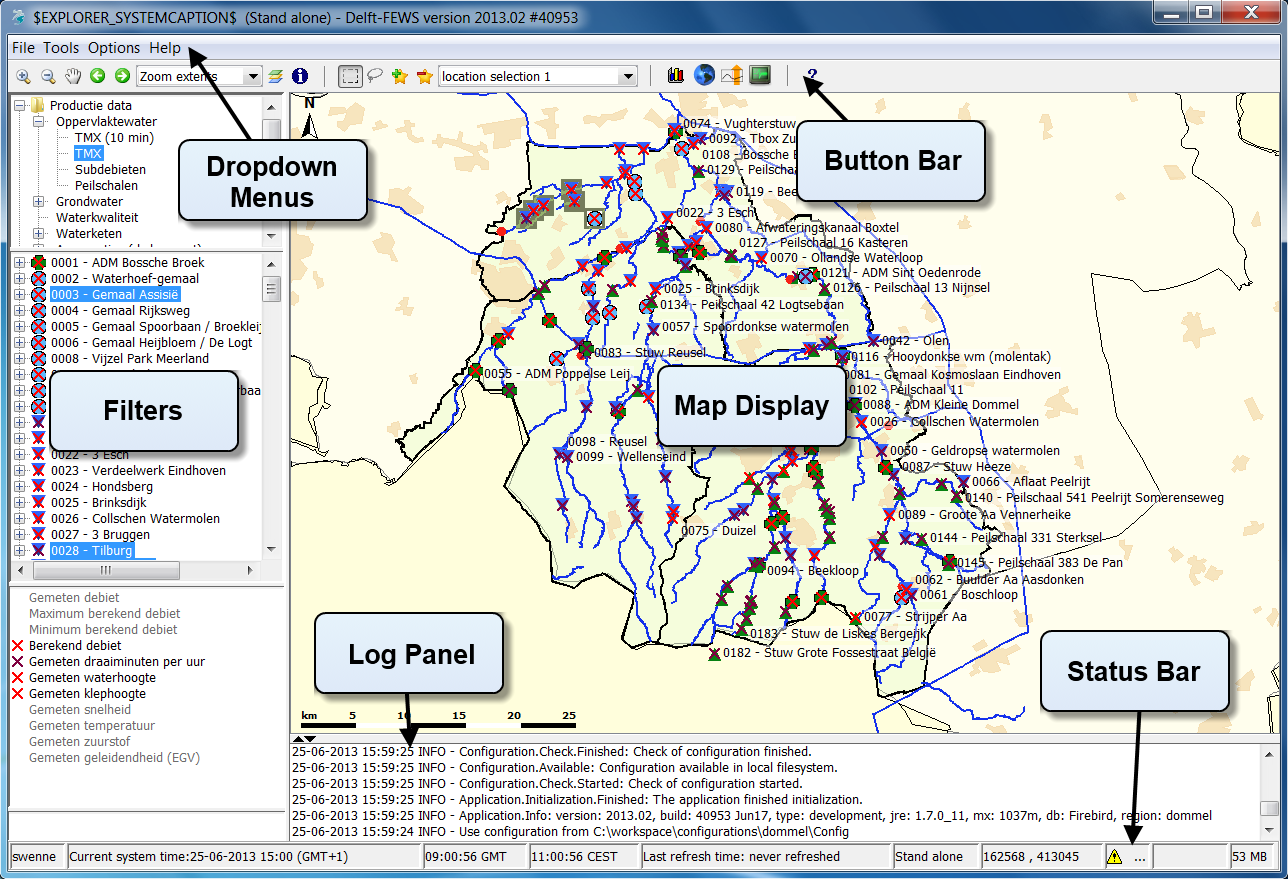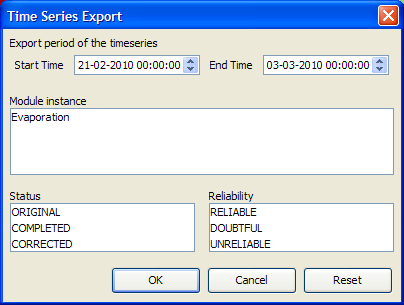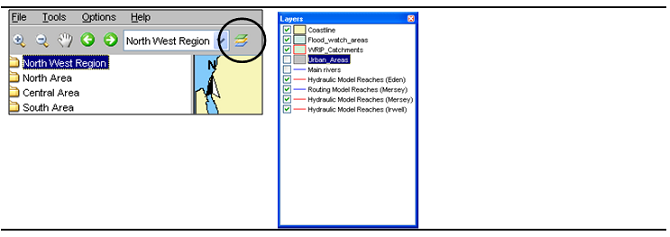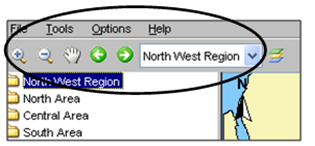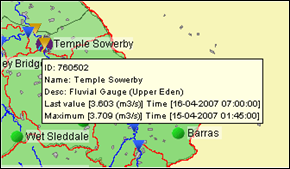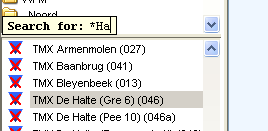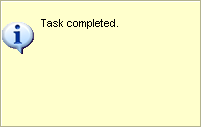FEWS Explorer
Overview
FEWS Explorer is the principal window of Delft FEWS. The main elements of FEWS Explorer are highlighted in the figure below.
Map display
The map display serves a double purpose. The first is to give an overview of the available locations given a combination of filters applied and to allow the user to select or deselect locations by clicking the location icon. The second is to provide a geographical background to the locations involved in the flood forecast.
Filters
The list boxes- also called filters- are required to identify the data to be displayed in a graph or table, or the icons on the map. There are four list boxes, from top to bottom:
- Time series groups
- Locations
- Data types (parameters)
- Forecasts
Drop down menus
The drop down menu bar provides access to all displays configured for your configuration of FEWS.
File - Export timeseries
This menu option opens the Export timeseries dialog.
This dialog can be used to filter the selected timeseries by view period, module instance, reliability and status. After the filter options are selected, the timeseries which match the given criteria are saved to a file. When the user selects in the Export timeseries dialog the reliability "unreliable", then only export formats that write quality flags are available, i.e. PI xml files, CSV files with quality flags and Dutch CSV files with quality flags. If "unreliable" is not selected in the export timeseries dialog, then all export formats are available. This is required, because if unreliable values would be exported without quality flags, then it would not be possible in the exported file to see which values are unreliable. In the case of csv format with quality flags, the complete text of the quality flags (including STATE and DETECTION flags, if they exist) are added to the timeseries. All export formats available in the Export timeseries dialog are: PI xml, GIN xml, csv, Dutch csv, csv with quality flags, Dutch csv with quality flags, iBever csv, Hymos transfer DB 4.50 mdb, Hymos transfer DB 4.03 mdb, Menyanthes csv and UM Aquo 2009 xml.
Button bar
The Tool bar provides quick access to frequently used tools. Tools are plug-ins to FEWS Explorer.
Log Panel
The Log Viewer relays high level messages generated by active system components. Additionally, detailed messages are available in the Log Browser.
Status Bar
The Status Bar provides information about the status of the forecasting system.
Map Display
Locations are displayed on top of the background map. The selected main filter determines which locations will be displayed. The background map may be configured to consist of stacked layering of various maps. For each map details about line types and fill colours may be set as well. Map layers can be disabled via the Layers button on the Button Bar..
Tooltip
Information that is displayed when the user is moving the mouse cursor over a shape. To see this information turn on the 'I' button, in the button bar.
Map navigation
Map navigation options are set in the zoom toolbar item. After clicking the '' button you can manually zoom in to a user defined map area. With the '-' button you can zoom out. Panning is possible after having clicked the hand button. From version 2008-01 the zoom in, zoom out and pan have been combined. After selecting the '' button, drawing a box from top left to bottom right zooms in, while bottom right to top left zooms out. Holding down the right mouse button allows you to pan. The buttons for zoom out and pan remain for users with only one mouse button.
Returning and moving forward between previously selected zoom extents can be done after clicking the arrow buttons. The drop-down allows you to select pre-defined zoom ranges.
Please note that in case you want to leave the zoom or pan mode, you have to click the buttons again.
Zooming with scroll wheel
Alternatively, zooming can be done with help of the scroll wheel on the mouse (when available). Zooming in and out is done by respectively turning the scroll wheel away and towards for the user. The position of the cursor determines the centre point of the zoom action.
Selecting locations
Locations in the Map Display can be selected by clicking on their icon. When selecting a location in this fashion, the locations selected in the Filters (to the left of the map display) will be adjusted to correspond with the map display. Conversely, if a location is selected in the Filters, the selection in the Map View will be adjusted as well. Multiple locations can be selected by holding down the [CTRL ] key while selecting.
In the Button Bar, there is a section further aiding location selection.
Rectangle selection: When selected allows you to press left mouse button and drag to create a rectangular box over the Map Display. When released it will select all locations contained in the rectangle. |
|
Lasso selection: When selected allows you to create a freehand selection in the Map Display. Press and hold the left mouse buttons and drag around the locations you want selected. Release to make the selection. |
|
Add location selection: Stores the current Map Display location selection. A Pop-up will allow you to enter a name for this selection. After entering the name and pressing OK, the selection can be found in the dropdown box to the right. |
|
Removes location selection: Removes the current item in the location selection dropdown box to the right of this icon. If there is no current item, or it is empty, nothing will happen. |
|
Location selection dropdown: When selecting an item from this dropdown, the locations contained in that item will be selected in the Map Display and the Filters. Selections can be added or removed with the Add / Remove location selection buttons. |
The stored selections endure a restart of FEWS and will only be deleted by manually removing them.
Show map layer information
An icon on the toolbar can be pressed to activate the presentation of information for map layers as a tooltip. If a map layer has been configured such that it shows information from the dbf file, a user can show this information by clicking the information button.
Note
In case the zoom mode has been activated, the desired location will not be selected, but the map will be panned instead. The zoom or pan mode must first be deactivated by clicking the magnifying glass again.
When moving the cursor to a location, a tool tip will be displayed with the following information:
- Location ID
- Location name
- Site description
- Information about time series...
- Last available value and date & time of last value
- Maximum value (in view period) and date & time of maximum
An example is given below;
The tooltip shown above is the default tooltip. Within Delft-Fews it is possible that the tooltip has been configured differently to e.g. display a picture of the location. Consult the documentation of your local system or the Delft-Fews configuration guide (locations) for more information.
Filters
The filters are the 4 list boxes at the left hand side of the FEWS Explorer. The filters are used to select the data to be displayed in a graph or table. Your selection can be filtered by making one of more choices in the list boxes.
Selection of location types
Time series sets can be selected in the upper filter. Time series sets are configured groups of locations with similar data types. The locations with the selected time series set(s) will be displayed on the map display and listed in the locations filter, the second list box. The data types associated with the locations are displayed in the data types filter, the third list box.
To select a list of multiple locations, hold down the [SHIFT ] key between the first and second selection. Hold down the [CTRL ] key to select multiple location types individually.
Locations list box
The locations associated with the selected main filter(s) are shown in the locations filter. Selected location will be highlighted on the map by means of a blue square. Locations can also be selected in the map display.
Location related icons are displayed on the map as well as in front of the location names.
Different icons are used to display locations and give information about the availability of data and about the hydrological status of the locations. More information about location related icons is given below in a separate section.
Data types list box
The data types associated with the selected main filter(s) are shown in the data types list box.
Selecting one or multiple data types causes the location list box to be updated regarding the potential availability of data, as shown by the icon displayed to the left of the location.
When depending on the selections made no data is available for a particular location or parameter its name is greyed out.
Forecast list box
The forecast list box displays forecasts that have been selected for viewing with help of the Forecast Manager. By highlighting one or more forecasts in this filter you can display them in graphs and tables.
Please note that- although not visible in the forecast list- the current forecast is always selected by the system. Icons related to the current forecast will be displayed on the map. The current forecast will also always be shown in the time series display. Selection of the current forecast is described in the section about the Forecast Manager .
The selection of forecasts in the Forecast list box can be removed by clicking the right mouse button with the cursor placed in the forecast list box. A pop-up menu appears with 'Remove all'. Pressing this menu item will remove the list of forecasts from the list box. Please note that this will just remove the selection but will not remove the actual forecasts from the database.
Location related icons
Locations related icons can refer to the following types of information:
- Location type icons
- Data availability icons (validation information)
- Hydrological status icons (threshold information)
Location type
For different types of locations different icons can be configured to allow for easier identification. Please note that only a single location type icon can be defined per location. In case for example various data types are available at a certain location that relate to different icons, the choice has to be made which icon will be displayed.
In Delft FEWS the following location icons have been chosen but in principle any icon could be chosen to represent a location type in FEWS.
|
gauged fluvial site |
|
ungauged fluvial site |
|
meteorological site |
|
radar data site |
|
coastal site |
|
catchment centre point |
|
default site |
Data availability and validation
In case all data is missing in the configured view period, a red cross will be displayed on top of the location icon. The configured view period equals the length of historic run for observed data and the length of the forecast run for forecast data. Note that except for the red cross the other icons have to be activated first via configuration.
|
no data available in view period |
|
data never written to database |
|
one or more timeseries completely missing (since 2011_02) |
|
missing data in view period |
|
soft validation limit exceeded |
|
hard validation limit exceeded |
|
data edited or interpolated |
If more than one are valid - both icons will be shown concurrently. By default only the red crosses are shown to add the addtional validation icons add the tag to the filters file
Hydrological and meteorological status
In case the high flow thresholds or rainfall thresholds are exceeded somewhere in the configured view period, the following icon is displayed.
|
a threshold exceeded in view period |
The threshold status icons are only displayed for the current forecast or selected forecast and observed data.
Together with the threshold icons information is displayed on the map to inform the forecaster on:
- the timing of the threshold crossing (historic or forecast period),
- the severity of the threshold crossing.
There are 5 extra icons pre-configured for 5 threshold levels that are merged with the original threshold icon. These extra icons are:
|
Level 1 threshold crossing in historic and forecast period |
|
Level 2 threshold crossing in historic and forecast period |
|
Level 3 threshold crossing in historic and forecast period |
|
Level 4 threshold crossing in historic and forecast period |
|
Level 5 threshold crossing in historic and forecast period |
For a level 3 threshold crossing in the historic period the combined threshold icon for a location will look as follows:
Search in list boxes
It is possible to search elements in the list boxes. Select the appropriate list box and start typing the search criteria, see examples below. The cursor jumps to the next element starting with the letters you typed. You can use the "*" sign in the search criteria if you do not want to start with the first character of the elements in the list box. When the search criteria turns red, the search criteria can not be found.
|
|
By using the up and down arrow keys you can jump to the next element in the list boxes that match the search criteria.
Log Viewer
The Log Viewer provides information about the status of tasks run by the system. The messages that are displayed by the Log Viewer- called System Messages- are meant for both end users and system managers. Typical system logs are the successful start and finish of a module run.
The following type of system messages are identified:
Log level |
Description |
Fatal |
Severe errors that cause premature termination |
Error |
Other runtime errors or unexpected conditions |
Warn |
Events that are undesirable or unexpected, but not necessarily wrong |
Info |
Runtime events (startup/shutdown) that allows tracking of the progress of the system |
Per message, the Log Viewer provides the following information:
- Log level (see table above)
- Time of creation
- Event code
- Log message
Further sorting and assessment of the messages can be done with help of the system Monitor (see also System Monitor ).
A System Manager can configure the system to also provide Debug Messages . These are used to log application internal events for system development and management. Typical debug events are the creation of a database connection or exceptions that occurred due to programming or configuration errors.
All messages listed in the Log Viewer can be removed from the display (not from the Local Data store) clicking the right mouse button with the cursor placed in the Log Viewer panel. Now two selections can be made:
- Clear Messages will remove all messages from the panel
- Save As will allow you to save the messages in the Log Panel to file
Status Bar
The Status Bar provides information about the status of the forecasting system. The information that is displayed can be defined by the user via the Options menu (see also Options ). Some information is always visible.
The following information can be displayed:
Operator name (always displayed)
The name of the operator that has logged in is displayed.
Current system time
The current system time is the time in which the system 'lives'. The current system time moves forward in the so-called "Cardinal Time Step". In the live system the current system time will generally be the same as the current time. For analysis purposes, the system time can be set back in the standalone system to simulate a particular situation in the past.
When the system time is set back, only information- e.g. observed data and external forecasts- will be available to the system with a time stamp before the set system time. In case an hindcast for a particular flood is made with the system time set back to for example 13:00 on 21 January 2004, only data, that where imported into the database before this time will be used by the system. The system behaves as if the current time was 13:00 on 21 January 2004. When part of the required import data streams were missing at that moment but have been received later, they are not used in the analysis.
In case however, the same analysis is done without setting back the system , all data until the current time will be available for the analysis. This means that in this case also the above mentioned missing import data will be used in the analysis.
FEWS time
This is the time that is configured in FEWS to display information.
Local time
The actual computer time. This is the time the user configures in the regional settings of windows.
Time of last refresh (only relevant for OC)
The time of last refresh indicates the last time the local data store has been synchronised with the Central Database. Not relevant for Stand alone FEWS configurations.
System status
The system status indicates in what mode the system is currently operating: online, or stand-alone.
In the live system the following colour information indicates the state on synchronisation:
- In case the colour is red, the OC is logged off:
- In case the colour is purple, the OC is synchronising with the MC displayed in system status box:
- In case the colour is green, the OC is logged on and fully synchronised with the MC displayed in system status box:
- In case the colour is tomato, the OC is doing Rolling Barrel (system maintenance)
Mouse co-ordinates
Mouse co-ordinates displayed in the configured co-ordinate system
System status icon (always displayed)
The System status icon- in the lower right corner of the display- indicates whether the system operates normally or that severe errors are encountered. The icon has the following display modes:
_Green __ ___
System is running normally but warnings have been encountered.
_Yellow __ ___
System encountered severe errors in the past 48 hours. This means that at least one system message has been generated with log level ERROR. After all messages with this log level have been acknowledged by the user via the System Monitor (see also System Monitor ), the icon becomes green again.
_Red __ ___
System encountered fatal errors in the past 48 hours. This means that at least one system message has been generated with log level FATAL. After all messages with this log level have been acknowledged by the user via the System Monitor (see also System Monitor ), the icon becomes green again.
Notification (default disabled)
Since 2007.02, the Explorer can be configured to provide a popup type notification to show completion of manually dispatched tasks. The popup appears in the lower left screen corner, reporting the name of the job dispatched as well as its success or failure.
